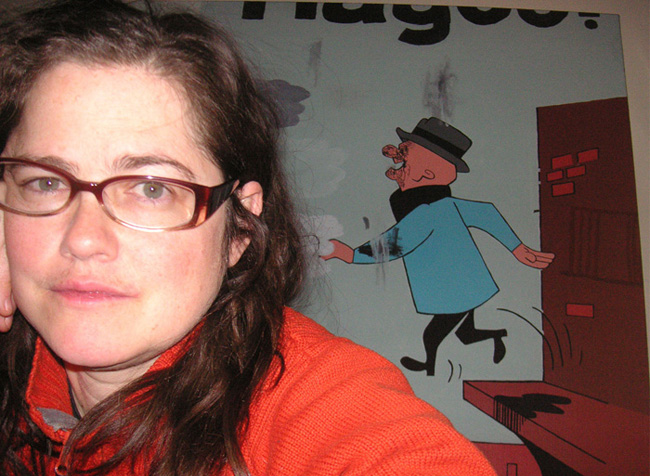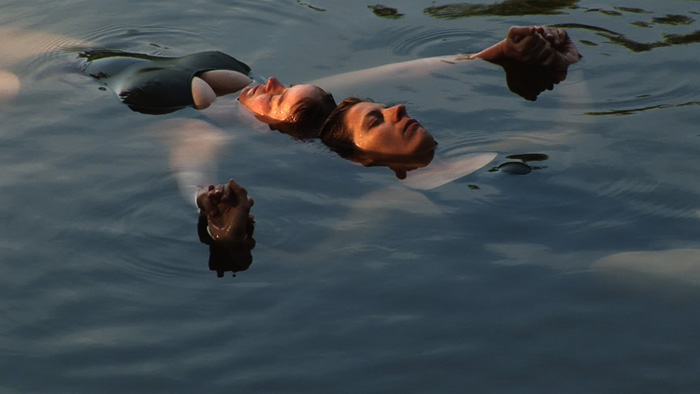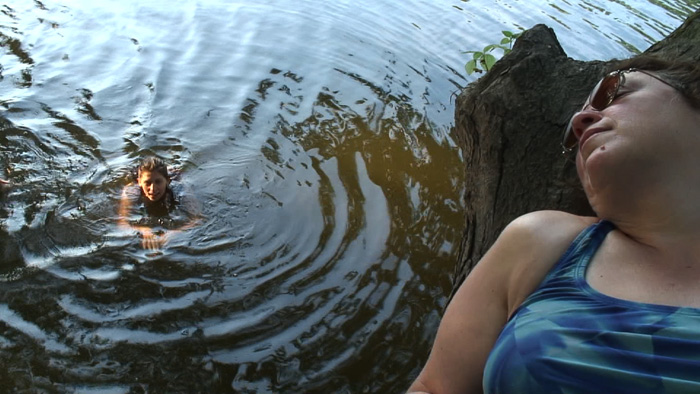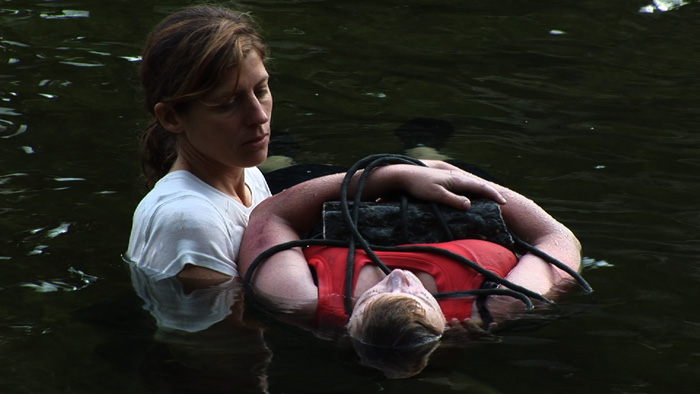Interview with
Jennifer Montgomery
By Penny Lane

Jennifer Montgomery’s most recent feature, Deliver (2008) has an astounding premise: an all-female remake of John Boorman’s 1972 film Deliverance, starring a cast of experimental filmmakers. Deliverance, based on James Dickey’s novel of the same name, is so iconic that even if you haven’t seen it, you probably know its “Dueling Banjos” theme, images of inbred hillbilly menace, and infamous “squeal like a pig” sodomy scene. It is foremost a film about masculinity. Deliver tracks the structure and plot of the original closely. The four businessmen on a weekend camping trip are recast as filmmaker-academics in need of a break, and the Georgia backwoods give way to the wilds of the Catskills–specifically, along a river called the Beaverkill (seriously). Peggy Ahwesh, Jackie Goss, Dani Leventhal, Meredith Root, Su Friedrich and Montgomery play the leads, backed by a handful of nonprofessional Hudson Valley actors.
If this project sounds kind of risky, that’s because it is. But Montgomery’s career is not marked by risk aversion. Since the 1980s, she has been making radically transgressive films, often bewildering critical sensibilities and audience expectations. She created an enduring impression with her first feature, Art for Teachers of Children (1995), a furiously ambiguous retelling of an affair she had at age 14 with her boarding school teacher. Art for Teachers of Children controversially rejected some of the pre-determined feminist language of rape and victimhood of the 1990s. Similarly confounding, Deliver is much more than a simple gender inversion. Montgomery takes her funny thought experiment to surprising and provocative depths, and Deliver tweaks our understanding of big ideas like gender, violence, birth and nature: an example of independent cinema at its finest.

Deliver / Jennifer Montgomery
PL: How did you come up with the idea of Deliver?
JM: Actually, it was Jackie Goss’ idea. She had this crazy idea that we should do a remake of Deliverance, starring all the elder feminist filmmakers–Joan Jonas, Yvonne Rainer, maybe VALIE EXPORT. [Laughs.] I just laughed and laughed, and I said I’d really like to make the film with her. I kept bugging Jackie to do it, but the more time went on the less enthusiastic she became. But I wouldn’t let it go. I was like a dog with a bone. [Ultimately], Jackie said she didn’t think the film would work, especially after reading the novel. She said Dickey was so squarely masculine. And I said, well, but that’s exactly why we should do it. In the end she turned the project over to me. It would be interesting to ask Jackie now if she still believes it was a bad concept. I came to believe it was a concept that had to be realized regardless of how bad it was. I knew it was going to be a disaster. I actually think the film is a disaster, but one that I had to make.
PL: It is an immediately compelling idea.
JM: It’s also such a setup for disappointment. People get excited about it on a populist level, but are often disappointed because it doesn’t [match] the sexiness or the thriller-ness of the original. But I defend that. I’m interested in disappointment. Disappointment, reenactment, and redundancy. I had this ongoing interest in reenactment, and I think of it in relationship to a feeling that women live with, [namely] that they’re redundant, that they’re not fully authentic, that they have to perform or reenact their gender.
PL: How did you go about casting?
JM: I convinced my friends to be in it. I set the film in the Catskills partly to make it easier for them to participate, but also because of my own interest in the class issues of the region. I cast it very quickly in my mind, and I think I cast well. I identified Peggy Ahwesh as the Burt Reynolds character [Lewis/Lou], because she had been a mentor to the rest of us, and because she has an interesting relationship to excess and control. Meredith Root played the banjo, and was totally up for it, so she played the Ronny Cox role [Drew/Meredith]. And of course, I was up for being savagely raped by Dani Leventhal and her companion, played by Nicki Aulicino, a friend of Dani’s from Rosendale. Ostensibly, I played the Ned Beatty role [Bobby/Bobby] because nobody else would do it, but it was absolutely accurate. I convinced Jackie to play the role of the Jon Voight character [Ed/Jay]. She maybe did it begrudgingly, but I think she did it really, really well. I think she could be a movie star if she wanted to; she has real star quality.
PL: In the early car scenes, the radio plays news about the Iraq War. Why was the war an important backdrop to this story?
JM: We were at war when Dickey wrote Deliverance and we are at war now. [Dickey’s characters] were men heading towards middle age, and they’re questioning their use value in wartime. Part of their trip out to nature was about reconfiguring or reclaiming their masculinity. The current wars in Iraq and Afghanistan are so pervasive that obviously it inflects contemporary art practice.
In preproduction for Deliver, Ihad a great deal of trouble configuring the rape scene. I had coffee with Jackie, and told her I didn’t know who these women were who [accost and rape my character in the woods]. And she had been thinking about it, even though this was long after she had detached herself from the film’s conception. She told me she had been thinking of Lynndie England, and the photos from Abu Ghraib. We talked about this idea of these women at Abu Ghraib posing with their victims. And for [the characters played by Dani and Nicki], I thought of them as these unemployed, excluded soldier wannabes hanging around in the woods looking for prey to pose with. So they became these sort of affect-less white women. I suppose I was also subconsciously channeling the military’s “Don’t Ask, Don’t Tell” policy, as well as the invisibility of lesbians in most federalized institutions.
Interestingly, Dani could not theorize what it meant for a woman to rape another woman, but she intuitively felt that it was possible. I am a person who has not only been raped, but who has also experienced physical and sexual abuse at the hands of a female lover. So I was coming from a very “this is for real” place with regards to the rape scene. This aspect of the film is not just a thought experiment [for me], and anybody who thinks that women can’t victimize other women is delusional. It’s one of the things that I was most passionate about, and I’m glad I got to express it.
PL: What’s interesting about the Lynndie England connection is that in her own life narrative, she seems to represent herself as a victim, much more than as a victimizer.
JM: Sure, that’s Victimology 101. I’m glad I played the character of Bobby, who was unlikable but also a victim. Because I hate being a victim. I hate the position of the victim, but I know all too well how easy it is to occupy that role. It’s a very comfortable place. But it’s also a prison cell.
PL: For so many people, the rape scene would be the stopping point for them as they tried to imagine making this film. You might be one of the few filmmakers in the world who could have conceived that scene the way you did.
JM: But even that scene is a failure, because the woman who played the rapist was a single mother, and had childcare issues, so she had to leave early. I mean, we’re in the middle of shooting this rape scene and she has to go! I’m like, “Are you serious? But–but–my underwear is hanging over this rock, and I’m bent over, and you’ve got the knife…” [Laughs.]
PL: I don’t think that scene is a failure. But I have to say, I’ve always been amazed by your work, which is marked by a kind of extreme risk-taking. Because of that, I find even your failures wonderful, because they’re not boring. They’re audacious failures–
JM: –the audacity of failure!
PL: Sure, isn’t that what experimental film is supposed to be about? What other risks were you consciously taking with Deliver?
JM: Well, it’s funny because the risks I thought I was taking were different than what turned out to be the real risks [of the project]. The risk I thought I was taking was that the film might end up as a kind of one-liner. I don’t think that ended up being a problem. The real risks were ultimately due to its being an extremely poorly organized shoot, with some real [physical] danger attached to it. Because of that, I ended up risking [some of my closest] friendships, which of course is folded into the narrative of the film. So I thought, okay, this has now become a Fassbinder-like theater of terror… I guess that’s appropriate. [Laughs.] I was totally alienated from the people I was working with, who were my dearest friends. I’m pretty sure I was universally loathed on the set. It was chaos. Some people did get injured, and when I went back the following summer to do pickup shots, I almost drowned on the Esopus, on baby rapids, really. But what’s really hilarious is that everybody has a making-of video. Su Friedrich has one where everybody shows off their injuries: “Here’s a scrape on my leg, here’s where I fell on my head!”

Deliver / Jennifer Montgomery
PL: Can you tell me a good making-of story?
JM: There’s a really nice scene where Peggy climbs a tree, and they all go swimming, and she pours beer into [Jackie and Meredith’s] mouths. Then there’s this bucolic Esther Williams scene with Jackie and Meredith. But the reason that scene even happened, and this is typical of the horrors of this shoot, is that everyone had gathered in Rosendale to get ready for some filming on the Walkill [River], and they were all waiting for me. And of course I showed up three hours late, in a horrific mood. Then I realized I forgot to bring the paddles. So we were literally up a creek without a paddle. [Laughs.] I went off in a huff to get the paddles, but really to run away. I said, “I’m going to Starbucks!” I drove around and around, and I was gone for three more hours. Once I left, everyone back in Rosendale just totally relaxed, and they shot up a storm, and created this beautiful scene, one of the nicest scenes in the whole film. And later I added pickup shots of my character sitting alone on the shore to cut in. It was a beautiful illustration of what happens when the director leaves everyone alone.
PL: How long was the shoot?
JM: About two weeks, and the bulk of us stayed at Dani Leventhal’s house up on the ridge in Rosendale. As with so many shoots, the film created its own temporary community: we ate together, we lived together. Dani’s house was the heart of the film. But I wanted to tell you the back story of why they end up in a birthing clinic. Connie Kieltyka, the woman who plays the deputy, is a midwife. When we were looking for a hospital in the area, she said if we shot late at night, we could use the birthing center where she worked. So I just added a line for Su Friedrich that explains why they’re in a birthing center. And before I knew it, Jennifer Reeder gave me a video of her first child being born, which was incredibly generous of her. She probably rues the day. Also, while I was editing, I was talking to my friend Jason Simon about how I was having trouble coming up with a title, and he [suggested] Deliver. All this is to say, I feel like the film is really [the result] of a lot of other people’s ideas that, to their horror, I realized. [Laughs.]

Deliver / Jennifer Montgomery
PL: You’ve said that you see your film as more an adaptation of James Dickey’s original novel than a remake of John Boorman’s film. Can you say more about the differences you see between these two texts?
JM: One of the reasons I was excited about this idea was that I read the novel as a junior in high school and it just blew me away. It was the first time I ever read the word “sodomy.” It was quite stunning. The novel has a lot of quietude and interiority to it, and Dickey writes about landscape in a very gendered, anthropomorphic way. In his book, nature is both feminine and angry. [In his adaptation], John Boorman leaned more toward making an action film. Deliverance is an amazing film, but I was more interested in making an inaction film. I knew I was making a narrative film that would proceed with the kind of retarded fits and stops that an experimental filmmaker who sees herself as outside of traditional narrative would craft. As a result, I think the film is fairly lumpen, and limited in its appeal.
PL: Can you talk about the role of landscape in your film?
JM: There are two attitudes toward nature that reflect a pretty pervasive Western conflict. There’s the Rousseauian, Edenic nature: nature is something to protect and conserve and leave untouched. Something we have to restore to its original state. Then there’s the Hobbesian view. Hobbes saw nature as dog eat dog, dangerous, something we have to protect ourselves from. Those conflicts are in play in the characters and also in the narrative. But there’s another kind of art historical dimension, which came out [while we were shooting the film], about the differences between the male figure in nature versus the female figure in nature. I guess I would call that the gendering of pastoral landscape. The cinematographer Megan Frasier and I would see women doing the same things that men would be doing [on a camping trip], but it would read as pastoral rather than as good old boys kicking back and having fun. It looked like hearth keeping, or gathering, but never hunting. Even the hunting scenes read as a confrontation between two victims: a woman with a bow, looking a deer in the eye, is one potential victim recognizing another potential victim.
PL: I was uncomfortable watching Jackie with a bow.
JM: Yes, because we had barely trained–more evidence of the rushed nature of the shoot–and so she didn’t know what she was doing. Those bows are intense. The pull is very heavy, and the arrows come flying out at 250 miles an hour. It’s true that there were some close calls. I wanted Jackie to use the arrows that you actually use to kill, the kind with two cross-hatched razors at the tip, but she wouldn’t even touch them. She would only use the blunt ones normally used for archery practice. The deer, though, were filmed near O’Hare Airport, so they’re Chicago deer. Jackie is shooting from a real long way away. [Laughs.]
PL: No wonder she missed. I have to admit that I questioned the physical competence of your characters: hunting with a crossbow, or boating on rapids. It didn’t seem like any of you knew what you were doing. I wondered how much of my reading was just plain sexist, and how much “real” incompetence I was detecting.
JM: I am happy that you asked me that question, because the question of competence is so interesting to me. I remember when I discovered Peggy Ahwesh’s films and totally fell in love and was inspired to become the kind of filmmaker [I became]. Someone had written that Peggy’s films were always on the edge of flying apart. That she was willing to take the risk of the charge of incompetence, the payoff being that you might get something utterly unique, and possibly far more real. The question of competence in relation to women and filmmaking is where my art lives. Every filmmaker should find a place of doubt that’s also transcendent. I don’t know what that is; it’s pretty much in the realm of poetics. But I know that when I was applying to Bard for my MFA, Peggy had to defend my films to a skeptical faculty, who thought the work looked incompetent. And, in defense of my films, she made up this term, the “fuck you” school of filmmaking: Super 8, hand-processed, 1-to-1 shooting ratio, a certain kind of unexplained intimacy, et cetera.
PL: A school of filmmaking that Peggy basically founded.
JM: Right, she did. When I was doing Super 8 films, I’ve had the experience of the splices breaking during a screening, and the reels literally flying apart and rolling out of the room, and I know Peggy’s experienced that too. [Laughs.] But I think that Art for Teachers of Children also had a certain kind of affect-less-ness, in the same way that some of Warhol’s work did. I would aspire to [the] level of affect-less-ness [that Warhol achieved], that says “fuck you” to the notion of trained acting. Which is something that I still feel, but not so aggressively [now]. I’m getting on in years. Deliver is sort of the bookend to Art for Teachers of Children. I shot Art for Teachers of Children at Bard [College, in Tivoli, NY] for my MFA thesis, which is not so far from where I shot Deliver, and it was a bitch to make, and I was a bitch to work with.
Deliver put an end to my “fuck you,” punk rock school of filmmaking days. It was almost like aversion therapy: I never, never, never want to make a film like that again. I knew the film was supposed to put an end to something. And after that, I started calling for an end to reenactment. There’s a lot of tilting at windmills in a career like mine, in making these radically unsuccessful feature length pieces. I mean, they’re not unsuccessful on all levels, but they’re unsuccessful in terms of what someone might think a feature length narrative film should do in this world. Right now, I’m really more interested in returning to an aesthetics of intimacy. Like mold. [Laughs.] There are these vats of food in my kitchen that I cooked earlier this summer, that I should have thrown away, but couldn’t because they got more and more interesting looking over time. I guess because I borrowed a [Canon] 5D [digital SLR camera], and that’s what you do with it. You use a 5D to shoot fucking beautiful images of mold. It’s like a lunar landscape in there. You have to come look at the mold, before you go. It’s amazing!
Published January 4, 2011
ABOUT THE AUTHOR
Penny Lane is a filmmaker and video artist whose work has shown at International Film Festival Rotterdam, Images Festival, Women in the Director’s Chair, AFI FEST, Antimatter, Impakt, and the Museum of Modern Art’s “Documentary Fortnight.” Her video-essay The Commoners (2009), made with Jessica Bardsley, appears in the second issue of INCITE. www.p-lane.com
INCITE Journal of Experimental Media
Back and Forth
